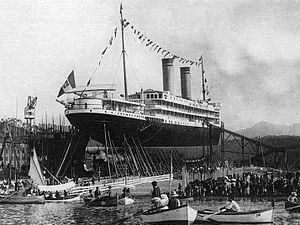 Principessa Jolanda just prior to launch, 22 September 1907
| |
| History | |
|---|---|
| Name | Principessa Jolanda |
| Namesake | Princess Yolanda of Savoy |
| Owner | Navigazione Generale Italiana |
| Port of registry | Genoa |
| Route | Genoa–South America |
| Builder | Cantiere Navale di Riva Trigoso |
| Launched | 22 September 1907 |
| Fate | Capsized during launch, scrapped on site |
| General characteristics | |
| Tonnage | 9,210 GRT |
| Length | 463 ft (141 m) |
| Beam | 56 ft (17 m) |
| Propulsion |
|
| Speed | 18 knots (33 km/h) |
| Capacity | 1,550 |
| Notes | two funnels, two masts |


The SS Principessa Jolanda was an Italian transatlantic ocean liner that capsized during her launch in 1907.
Built by Cantiere Navale di Riva Trigoso for the Navigazione Generale Italiana (NGI) shipping company and named after Princess Yolanda of Savoy, the eldest daughter of King Victor Emmanuel III, the ship was intended for the NGI's South American service. At 9,210 tons and 141 m (463 ft) in length, she was the largest passenger ship built in Italy up to that time.[1][2] Constructed at a cost of 6 million lire to designs by Erasmo Piaggio, the Principessa Jolanda has also been called the first true Italian luxury liner. She was among the first transatlantic vessels fitted with Marconi Wireless telegraphy, electric lighting throughout and telephones in each cabin.[3]
At 12:25 pm on 22 September 1907 the nearly completed Principessa Jolanda was launched before a large audience of onlookers, government officials and foreign journalists. After travelling down the slipway, the ship immediately became unstable and heeled sharply to port. Efforts by tugboats and shipyard workers to rescue the situation, including lowering the anchors to starboard to counteract the movement, were unsuccessful. After 20 minutes the vessel's list was such that it began taking on water through openings in the upper decks. She soon capsized with her funnels a few metres above and parallel to the water. Within an hour she finally slid lower until only a few feet of the side were visible.[1] The captain, his guests and the workers onboard had just enough time to escape in the lifeboats. There were no casualties.[4]
Although brand new, she was deemed unsalvageable and the wreck was broken up on site. The engines were salvaged and used in another vessel, now believed to be the SS Milazzo.[5]
- ^ a b "Merchant Ships: The Disaster at Riva Trigosa, Italy". Journal of the American Society for Naval Engineers. 19 (4): 1116–1120. November 1907. doi:10.1111/j.1559-3584.1907.tb04163.x.
- ^ Ships Monthly, Volume 40 (London: Endlebury Publishing, 2005) p. 44.
- ^ A. Pascale: "Le installazioni radio sulle navi italiane" in: L'isola nave e la memoria degli ultimi marconisti (Cagliari: Davide Zedda Editore, 2007) ISBN 978-8895164748 (in Italian) p. 51
- ^ Liner Sinks When Launched. The New York Times, 22 September 1907. online abstract. Retrieved 08-Aug-2012
- ^ Thomas E. Bonsall: Great Shipwrecks of the 20th Century (New York: Gallery Books, 1988) ISBN 978-0831777814